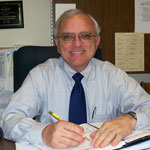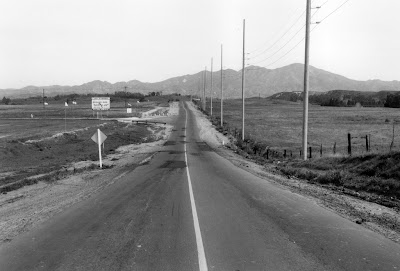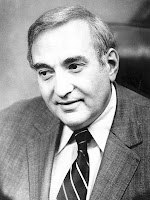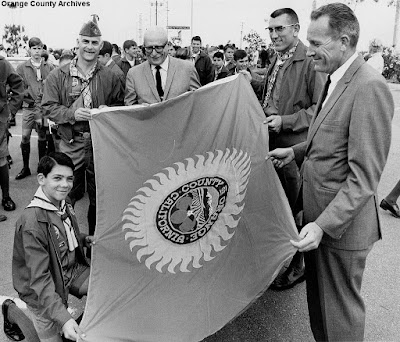The entire “Fuentes/Shooting Star” saga can be found
here.
For those of you with the patience, I have more background on the “Shooting Star” story. You’ll recall that the yacht, Shooting Star, disappeared off the coast of Baja California in June of 1974, taking ten men with her, including Orange County Supervisor (5th District) Ron Caspers and political consultant Fred Harber. Harber was a key strategist for Dr. Louis Cella and his “shadow government” (to use OC DA Cecil Hicks’ phrase), which included in its stable four Supes, including Caspers. Caspers’ “executive aide” at the time of the Shooting Star incident was Tom Fuentes, who, it is often reported, decided to pass on the trip at the last minute, but not before he packed an extra ice chest for his boss filled with hors d’oeuvres and drinks.
In my last post, we learned (based on the account of one-time OC GOP chair Tom Rogers) that Caspers, a Republican banker, engaged in foul deceptions to tarnish the reputation of 5th District Supervisor Alton Allen, whose office he evidently coveted.
Below are excerpts from two articles from the January, 1976, edition of The California Journal. The first, by Dan Walters and his partner, describes Dr. Cella’s relationship to former Buena Park Mayor Fred Harber. Here, Harber emerges as a more interesting, and perhaps important, figure (at the time of the Shooting Star disappearance, he was 55 to Caspers’ 43 years of age).
We also learn that Cella, (OC land baron) Richard O’Neill, and Harber partnered with a man tied to the mob.
The next article, written by Nancy Boyarsky, briefly discusses Dr. Cella’s background. These details are pretty interesting.
The last pair of articles, from the LA Times, have no very clear relationship to the Shooting Star/Cella saga. They concern the mysterious 1994 murder of a much-beloved woman who had worked as an assistant to many of the characters who have cropped up on these pages. Arlene Hoffman was slain, evidently, with an arrow from a cross-bow, in her Laguna Niguel home. The murderer took the arrow with him.
Her murder has never been solved.
She was once Fred Harber’s secretary at one of Louis Cella's hospitals. She had also worked for "Big Daddy" Jess Unruh and Norton Simon. At the time of her death in 1995, she had just been hired by new OC Supervisor Jim Silva.
The Tangled Web: Two
By Al Downer and Dan Walters
. . .
Mysterious figure [Dr. Louis Cella]
Cella, whose business interests range from ranching to real estate but are concentrated in the medical field, is the mystery man of Orange County politics. Rumors about him and his political and business deals abound, but most of them evaporate under scrutiny.
Cella operated behind-the-scenes until 1974, when he lost his front man, Fred Harber, who had been Cella’s chief political aide and sometimes business associate until his disappearance in June 1974. He and nine other persons, including Orange County Supervisor Ronald Caspers, vanished when Harber’s boat apparently sank off the coast of Baja California. Caspers was a member of the Cella-ONeill stable and his family savings-and-loan company had provided at least some of the financing for Cella’s chain of hospitals. “Harber was smooth, and as long as he was around things operated quietly with no fuss and muss,” says a knowledgeable Orange County observer. Harber operated out of one wing of the Cella clinic across the street from the county courthouse and once was on the payroll as an assistant to Supervisor Robert Battin, another organization politician who is now under indictment for using his staff in a political campaign.
[State Controller Ken] Cory has described Harber as “a very good friend of mine, perhaps the best friend I have had.” And with good reason. Harber not only was the tactician for Cory’s early political successes, but he loaned Cory’s small insurance agency, Cornet Insurance Counselors, $95,250 in 1967 when the agency appeared to be having difficulty making payments on a note.
Harber and Carl D’Agostino, now Cory’s deputy controller, were the co-founders of Demographic Communications Consultants, a campaign-management firm that has handled many campaigns for the Cella-ONeill organization. With Harber’s passing, Cella was forced to move into the open, and investigators began taking an interest in his complex of business affairs. Orange County District Attorney Cecil Hicks, perhaps the only major Orange County official openly hostile to Cella and O’Neill, has called Cella the man behind “a shadow government”. Cella hired a private investigator, through one of the hospitals, to investigate arch-enemy Hicks.
. . .
More ties
The influence of Cella and O’Neill in county government is apparent in many ways. A prime example is the El Toro case.
El Toro Land Company was formed as a partnership in 1970 to develop a 39-acre parcel along the San Diego Freeway in Orange County. One of the original partners, with a $25,000 investment, was Albert Parvin, one-time Las Vegas casino-owner and head of the Parvin-Dohrmann Company and the Parvin Foundation. Meyer Lansky, reputed Mafia financial brain, was one of Parvin’s partners in the Flamingo Hotel and the Parvin Foundation had former Supreme Court Justice William O. Douglas on its payroll for $12,000 per year – a revelation that sparked an impeachment effort against Douglas several years ago.
Cella, O’Neill and Harber bought into El Toro Land in 1971 and remain as major partners, along with Parvin, according to corporate records. Shortly after they bought in, the Orange County Board of Supervisors took emergency action to establish a freeway interchange adjacent to that property and the land increased in value by 600 percent, county records show.
As Cella and O’Neill were expanding their business and political empires, Cory was experiencing a growth of personal wealth and political influence. Cory, who attended four colleges and graduated from none, became involved in politics while still a teen-ager. He went to Sacramento in the early1960s as an aide to then-Assemblyman Richard Hanna, the first Democrat to achieve major office in Orange County in recent years, and Cory served on the staff of the Assembly Education Committee, which was chaired by Hanna.
. . .
The Tangled Web: Three
Richard O’Neill—last of the big spenders?
By Nancy Boyarsky
. . .
An enigma
The 51-year-old physician [Lou Cella] is something of an enigma. Two popular exercises in Orange County political circles are estimating the size of his wealth and speculating on its source. The estimates on size range from $50 million to $500 million, although he generally is regarded as being less wealthy than O’Neill. Even his closest business associates, including O’Neill, don’t know the extent of Cella’s business interests. And Cella’s own explanations elude verification. It is known that he came to Orange County about 20 years ago from Providence, Rhode Island, where his father was also a physician and political figure. But the elder Cella left an estate of less than a quarter-million dollars. Cella came to Orange County after losing a position as senior resident surgeon at Rhode Island Hospital. The hospital’s staff had given him a vote of “no confidence”. Cella had been expelled from one medical school for cheating and eventually graduated from another. Although he has maintained a small private practice in Santa Ana, Cella’s chief occupation in California has been that of businessman and political operative. He is involved in at least seven Orange County hospitals and has wide real-estate and other investments. The Internal Revenue Service says, however, that Cella hasn’t filed an income tax return for the past three years.
. . .
…From 1972 to 1974, she worked as a secretary for a political consulting firm called Fred Harber and Associates.
. . .
"She spent everything they had trying to prolong his life," said Lyle Overby [you'll recall that he was on the Shooting Star but disembarked at Cabo], a political consultant and friend of 20 years whose admiration for Arlene Hoffman led him to recommend her to Silva….
NANCY WRIDE - TIMES STAFF WRITER
LAGUNA NIGUEL — Portions of drywall were hacked away from her condo in a futile hunt for clues. Detectives asked childhood friends and family to undergo fingerprinting and lie detector tests to narrow the field of suspects. Her son even offered a $25,000 reward from his inheritance for details leading to the conviction of the killer.
But, one year later, the mystery remains unsolved as to who fired a hunting-type arrow through the chest of Arlene Hoffman, leaving her to bleed to death on the marble floor of her Laguna Niguel foyer.
Hoffman, 57, widowed nine months earlier, was long active in the backfield of Southern California political campaigns. Shortly before she was found slain Dec. 30, 1994, she had been hired as personal secretary to Jim Silva, newly elected to the Orange County Board of Supervisors.
. . .
Simply put, there was little if any physical evidence at the scene to trace back to Hoffman's killer—no shell casings or fingerprints, no permits or licensing required to buy or use an arrow, no weapon left behind….
*
In her lifetime, Hoffman moved in some high-profile circles. In the 1970s, she was connected to some of the major stories and players of the day.
She worked for the late millionaire industrialist and world-class art collector Norton Simon, up to and including his failed campaign for U.S. Senate in 1970. She was involved in other political campaigns, including former Assembly Speaker Jesse M. Unruh's unsuccessful 1973 bid to become mayor of Los Angeles. She was secretary to Fred Harber, a political consultant who vanished at sea off the coast of Baja California in June 1974.
In 1976, she was called to testify as a witness before the Orange County Grand Jury investigating political corruption.
Hoffman told the grand jury she was an employee of the hospital run by Dr. Louis Cella, a political kingmaker and largest campaign contributor in California at the time. Now dead [sic], Cella was accused of billing Medi-Cal for nonexistent patients, then funneling the money into the campaigns of numerous candidates who went on to hold major office. He ultimately was convicted of income-tax evasion, Medicare and Medi-Cal fraud, embezzlement and conspiracy. He spent 31 months in federal prison.
Investigators believed Hoffman was on the payroll of a state-funded hospital but was actually working on political projects at Cella's behest—such as mimeographing campaign hit mailers out of the hospital's print shop. District attorney investigators say now that they believe she lied to protect her employers. Cella ran the first campaign of former Orange County Treasurer-Tax Collector Robert L. Citron, who has pleaded guilty for his role in the county's bankruptcy.
Because Hoffman's slaying occurred in the high-anxiety days after the nation's largest municipal bankruptcy, the case has seemed ripe for speculation about a political connection. But beyond smoky rumor, investigators say, no such link between Hoffman's death and the bankruptcy has crystallized.
*
By nightfall on Dec. 30, 1994, there was no call from Hoffman's cellular phone, no sign of her Mercedes-Benz in the county government parking lot. Supervisor Silva, whose entire family had become quite fond of Hoffman, grew worried and personally called Sheriff Brad Gates to have deputies check his secretary's condo. They found her dead in her hallway, the victim of an arrow possibly fired from a crossbow. An autopsy placed her death sometime during a 12-hour period between 7:30 p.m. Dec. 29 and 7:30 the following morning.
Detectives have not recovered the arrow—which might have passed through her body or been removed from it by the killer. Her dog was skittering around the entryway, its bark surgically squelched by a previous owner. The front door was unlocked and there was no sign of a break-in.
Inside her garage was her Mercedes and her cellular phone. Nothing of any value appeared missing from the house. Partial fingerprints taken from a stairway from which investigators suspect the killer fired the arrow down on Hoffman didn't lead to an arrest.
Archery shops and sporting good stores in the region were questioned for leads.
"They've interviewed everyone who ever had contact with her or might have had contact with her," Wilkerson said, "and any place she might have frequented, employees."
Her relatives declined to discuss the case, requesting privacy in their grief. Her son, Charles Anthony Hoffman, 26, who was talkative July 12, 1994, when he announced the reward for information leading to the conviction of his mother's killer, did not return phone calls….
No creditors emerged, court records show. There were not even any claims stemming from the personal bankruptcy she and her late husband, Joel, filed and had resolved two weeks before his death in March 1994 after battling cancer.
Hoffman leased her condo from her sister and brother-in-law, Joanne and John Dougherty, who friends say wanted her close to them in Dana Point.
The condo was sealed off for several months during evidence gathering. Then came cleanup and repairs totaling $12,000 from damage caused by the slaying and police investigation.
Wilkerson said Hoffman's son eventually made the condo his home—at least for several months after that.
At the time he offered the $25,000 reward, Charles Hoffman said he hoped it would lead to an arrest and some "closure" for his family, which had suffered two deaths within a year.
In the year since her death, though, there has been no closure.
The Sheriff's Department has not received any calls responding to the reward, Wilkerson said, and they have no fresh clues.
The family still grieves.
And everyone still wonders why someone would kill Arlene Hoffman.





















